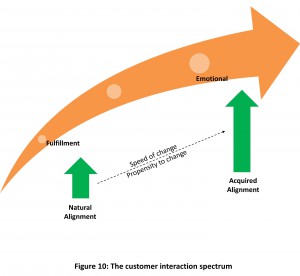Before you decide to adopt a roadmap of actions for your firm, the key question to answer is “Where am I playing today and where should I be”. A critical element of that is customer engagement. What models are we using to interact and engage with your customers?
I consciously decided to stay away from defining named segments for companies because they are often misleading. For example the article on Booz.com (now Strategy&) at http://www.strategy-business.com/article/00241 outlines 4 types of companies in order to explain the 4 digital marketing models. According to me, that analysis is OK for the very short term – when you are thinking about what to do in the next 2-3 months – but it sort of misses the mark for the long term.
 My model instead depicts a continuum. A company can and does operate at both ends of the spectrum. The important point is to move from physical connections with the consumer to the emotional, in a way that’s right for your firm. And at a strategy level, the capabilities that you need must be aligned as per that strategy. That leads to deeper customer engagement because how you want them to perceive you matches with how they actually experience your brand (not just in advertising or positioning, but during transactions and customer service).
My model instead depicts a continuum. A company can and does operate at both ends of the spectrum. The important point is to move from physical connections with the consumer to the emotional, in a way that’s right for your firm. And at a strategy level, the capabilities that you need must be aligned as per that strategy. That leads to deeper customer engagement because how you want them to perceive you matches with how they actually experience your brand (not just in advertising or positioning, but during transactions and customer service).
This customer engagement model changes the perspective because it refers to the top down strategy first. And there’s really no other choice today. Successful firms must connect with consumers at both physical and emotional levels to be relevant. When experiences drive transactions, and also vice versa, then you’ll know you’ve succeeded.
The impact of this principle can be seen from the enormous amount being spent on advertising and promotions. And in most cases, we fail to reinforce the emotional messaging that attracts the customers. We portray exclusivity, respect, honesty, and then we provide the same undifferentiated mechanized experience to customers. However, when you walk into a bank, or use their services, is there really a difference? Likewise, is there really a difference between how one luxury retailer behaves compared to another. For the most part, their products are undifferentiated too. And it shows in customer engagement. Slogans and branding don’t cut it anymore.
In this model, I’ve outlined how to understand what our current interaction model for customer engagement is. Some transaction heavy industries such as banking have a higher customer interaction index. They are at an inherent advantage when it comes to tying the 2 ends of the spectrum together. Likewise, some consumer product oriented organizations are lower when it comes to the inherent customer interaction index, and rely on emotional branding. The roadmap to deep customer engagement is to think of making progress on both ends of the spectrum. The principle outlines several avenues to do so.
Read more about this and the other 4 principles in my book :”Dancing the Digital Tune: The 5 Principles of Competing in a Digital World“.

Pingback: Bed Bath & Beyond Bankruptcy: Looking Past the Red Herrings - Dancing The Digital Tune
Pingback: A new(er) way to look at innovation in customer experience - Dancing The Digital Tune
Pingback: The Question of Loyalty - Competing In Digital